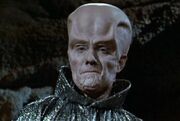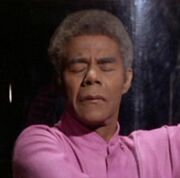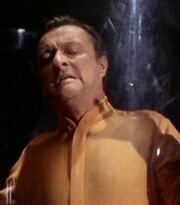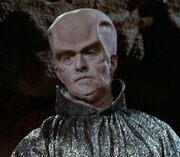There were four TOS episodes that for many years weren’t shown on the BBC. I think they were left out of the original run (c. 1969) because of attitudes back then, and it just took a long time for somebody to include them in a repeat showing.
Anyway, they were “The Empath,” “Whom Gods Destroy,” “Plato’s Stepchildren” and “Miri.”
This episode was written by Joyce Muskat, one of only four fans who were able to sell scripts to the original series; the others being David Gerrold, Judy Burns, and Jean Lisette Aroeste. Co-producer Robert Justman read her unsolicited script and recommended it be bought.
The BBC wouldn’t show this series until 1994 because it was too violent. Trek books are always making fun of NBC standards & practices, but the BBC seems more skittish.
The empath, b. 1933 in Princeton, Ill. Kim on As the World Turns from 1972 on. During “Empath” she was married to Glenn Ford. IMDB credits start with Hawaiian Eye and Surfside Six in 1962, continue with Alfred Hitchcock, Kraft Suspense Theatre. The Virginian, Bonanza, High Chapparal, The Man from UNCLE, The Road West, Night Gallery, even a Law and Order and a Law and Order: SVU in recent years.
Wiki says, “Hays played bit parts in many sitcoms and drama series throughout the 1960s and into the 1970s … Billed as ‘and introducing Kathryn Hays,’ she had a major role in a June 1962 episode of Naked City, ‘The Ryedecker Case.’ The script was written by Gene Roddenberry. Hays appeared on the Roddenberry’s series The Lieutenant.”
In 1968 she appeared in a New York stage production of Dames at Sea that starred Bernadette Peters just starting out.
Big-headed alien. Born in NYC. ’60s/70s tv, some familiar titles: High Chapparal, Mannix, Wild Wild West, Big Valley, M:I, Bracken’s World, etc., plus a few movies. IMDB lists first credit in 1963 on soap The Nurses (episode’s incredible title: “To Spend, to Want, to Give”), last credit for main career is “Director” on a 1977 Wonder Woman ep where she visits Hollywood, so I guess he was just playing a director. A long while after, we get one last credit “Mr. Kramer” in the 1997 film Turbulence, a would-be action blockbuster from MGM that starred Ray Liotta and Lauren Holly. Yish.
Black doctor, b. 1917 in Mobile, Ala. “More than 30 feature films,” something in Roots, Gunsmoke, I Dream of Jeannie, All in the Family, Sanford and Son, Mary Tyler Moore Show. IMDB and MemAlpha don’t quite match up, but guy may have had more than a hundred roles from circa 1950 to 1993. The Killers with Reagan (1964), To Sleep with Anger (1990). Lot of tv from mid-1950s into 1980s. A role in Jungle Drums of Africa (1953) as “Native Ambusher.” In the very early years he even did the Amos and Andy tv show (he was “Mr. Royal,” one ep).
Boba Fett’s voice. B. 1919 in Brooklyn. Plus he was in Twilight Zone’s famous “A Stop at Willoughby” and another ep, “Midnight Sun.” And he was “Man #2” in a Seinfeld (“The Opera, 1992). Voiced Boba in pre-2004 versions of Empire Strikes Back. His “Empath” role is as an earth scientist who gets tortured and killed by the aliens.
IMDB lists about 150 roles, going back to 1955 and Armstring Circle Theatre, ending with In the Heat of the Night in 1994.
Wiki says, “best known for his role as Harry Snowden on the classic television sitcom All in the Family and its spin-off series, Archie Bunker’s Place. He played the character from 1977 until 1983.. … regular during the 1960-61 season of The Untouchables, playing Police Captain Dorsett…. recurring role as Judge Arthur Beaumont in the series Matlock guest-starred in … Mission: Impossible, The Outer Limits, Bonanza, The Rockford Files, and The Fugitive,” among others. Also was in Roots: The Next Generations.
Another alien, b. 1922 in Canada. IMDB gives him 82 credits from 1943 to 1974, when he died. “Second Reporter” on The Lloyd Bridges Show, things like that. In 1963 appeared as “Self” in The Man Nobody Liked, which IMDB lists as a documentary. The cast also had Philip Boyce, who was the Enterprise medical officer in “The Cage” (Star Trek’s first pilot). Weird. Apparently it was a service film.






I'm surprised to hear the BBC wouldn't show Star Trek. Their own series Blake's Seven was at least as violent as Trek, and the original Doctor Who was at times more gruesome.
On the other hand, it was unconvincingly low-budget violence, which may have made a difference.
There were four TOS episodes that for many years weren't shown on the BBC. I think they were left out of the original run (c. 1969) because of attitudes back then, and it just took a long time for somebody to include them in a repeat showing.
Anyway, they were "The Empath," "Whom Gods Destroy," "Plato's Stepchildren" and "Miri."